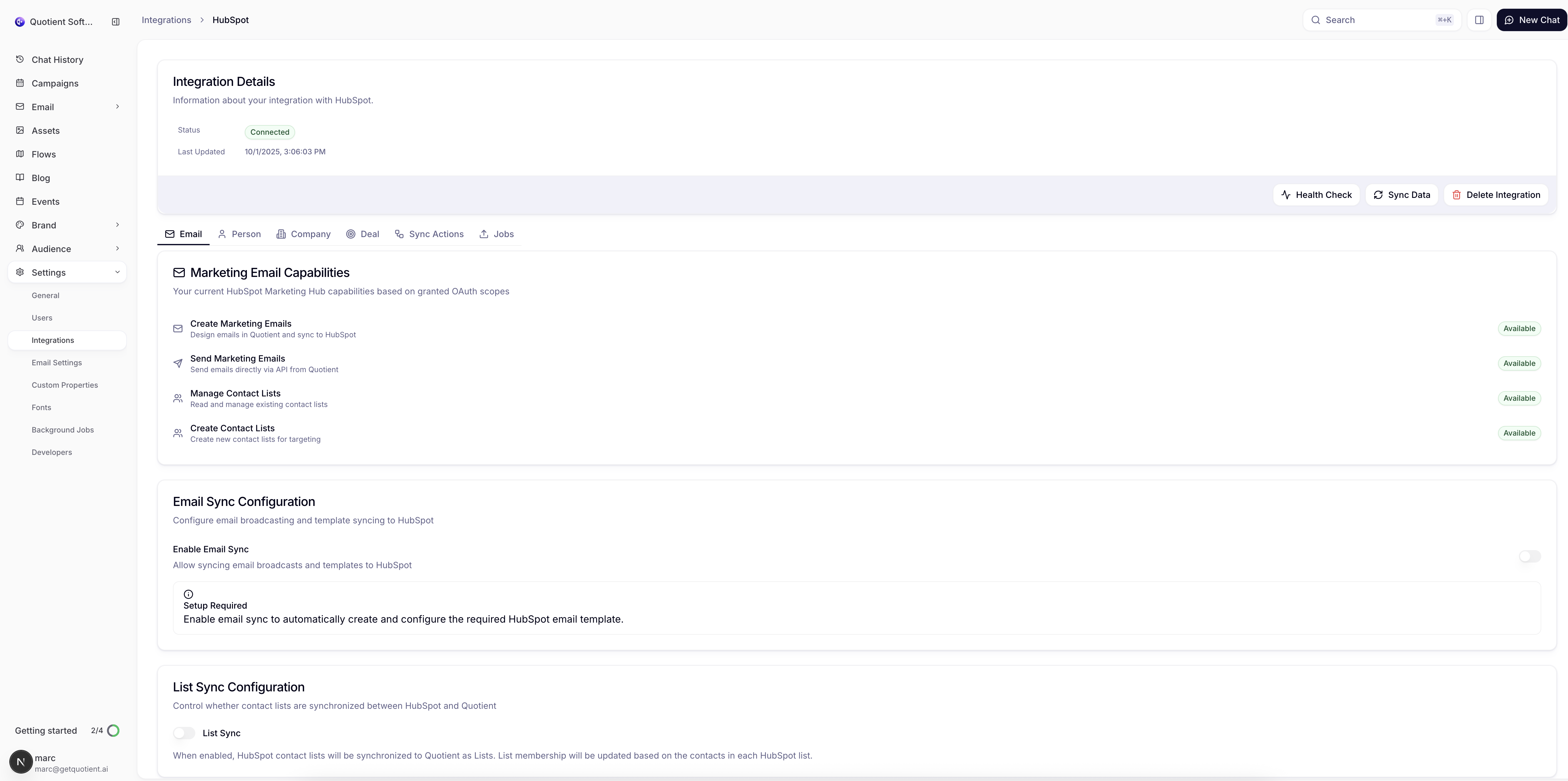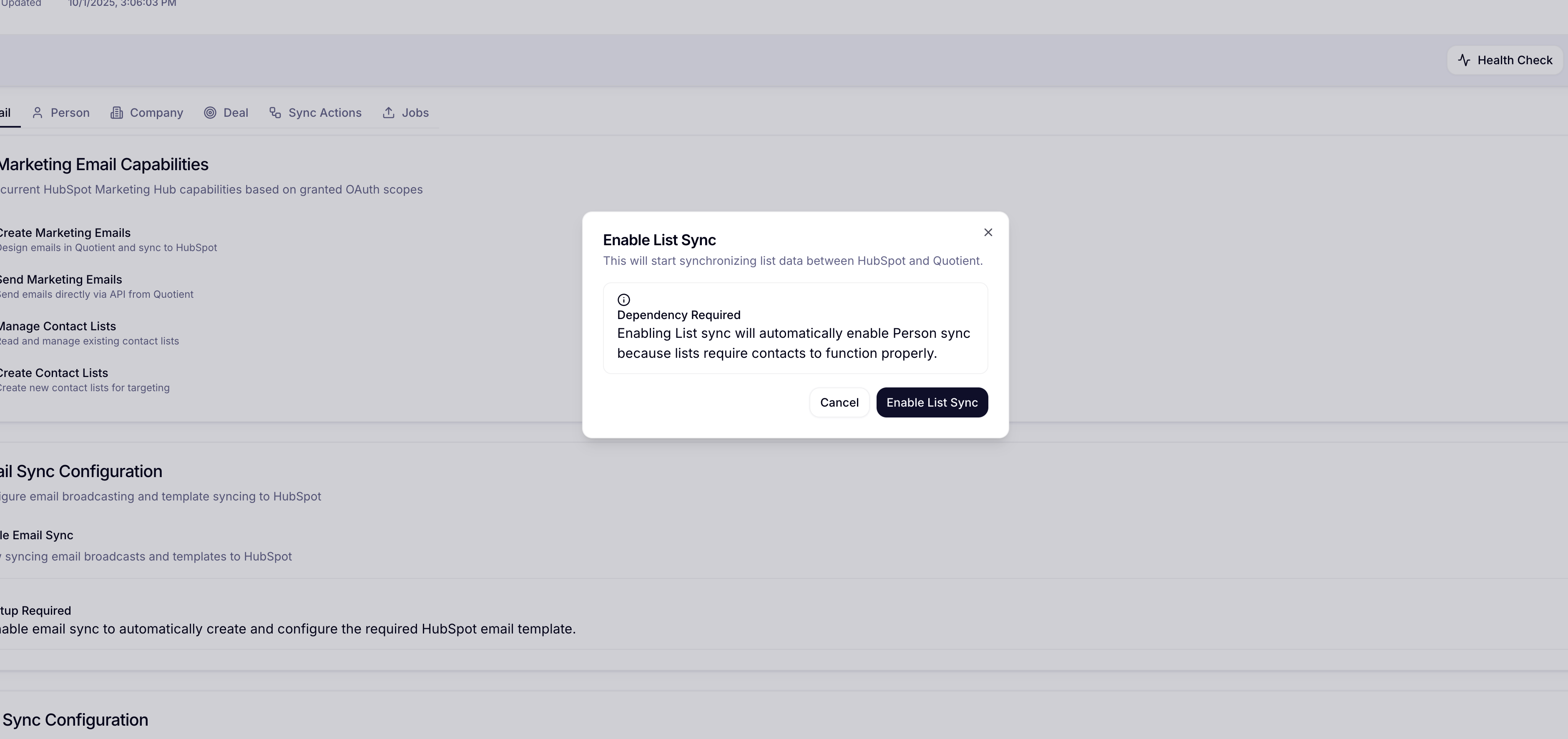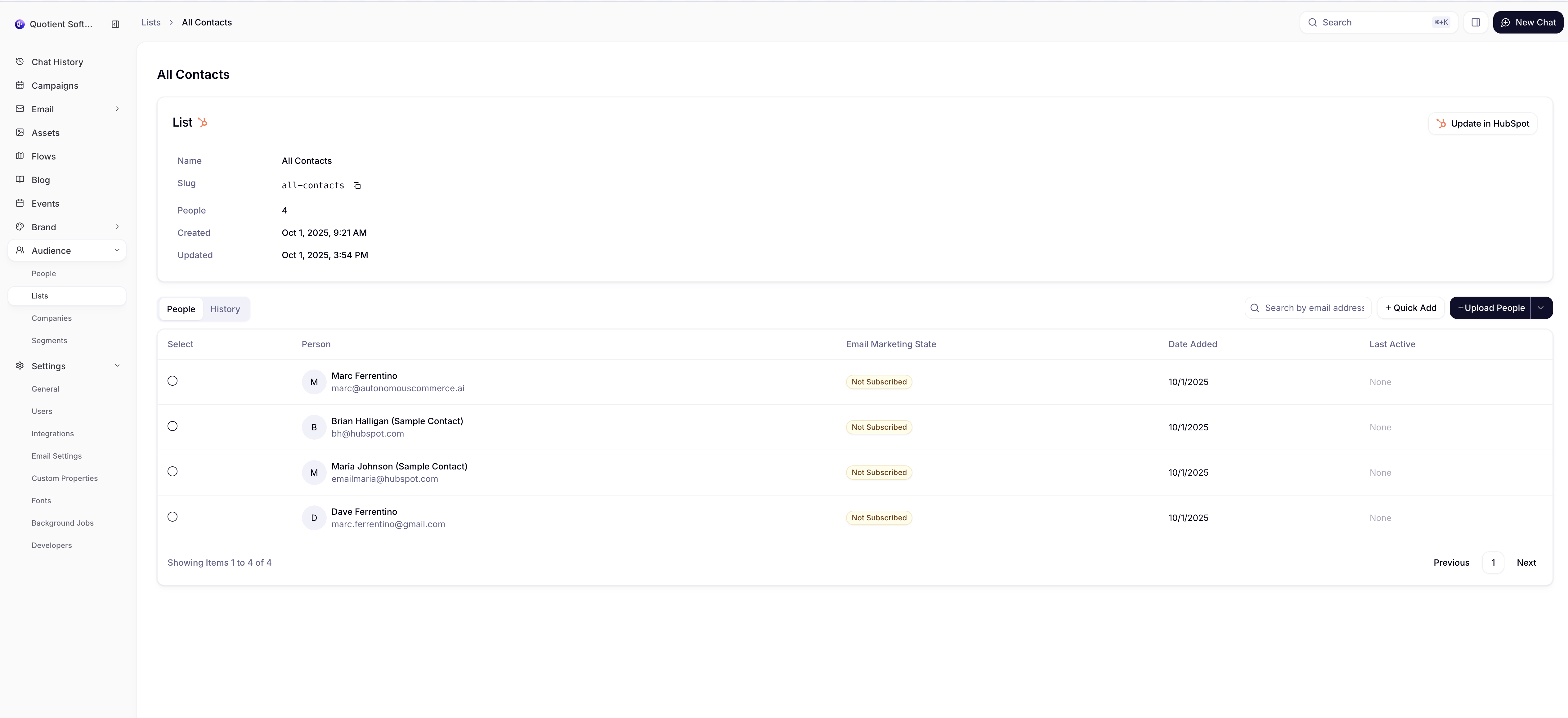List & Segment Synchronization
Understand how HubSpot lists sync with Quotient segments and lists, including dynamic vs static behavior
Overview
HubSpot's list system works differently from traditional static lists, offering both dynamic (automatically updating) and static (manually managed) list types. Quotient's integration intelligently maps these to the appropriate Quotient equivalent: dynamic lists become segments and static lists become lists.
This smart routing ensures that the automatic updating behavior of HubSpot dynamic lists is preserved in Quotient segments, while static lists maintain their manual management characteristics.
Understanding HubSpot List Types
Dynamic Lists (Active Lists)
Dynamic lists in HubSpot automatically update their membership based on criteria you define. When a contact meets or stops meeting the criteria, they're automatically added or removed from the list.
Key Characteristics:
- Automatically maintained by HubSpot based on contact properties
- Automatic updates when contact data changes during sync cycles
- Criteria-based membership using HubSpot's filtering system
- Cannot manually add/remove contacts - membership is determined by criteria
Common Use Cases:
- Contacts in a specific lifecycle stage
- Companies with revenue above a threshold
- Contacts who haven't been contacted in 30 days
- Leads from specific marketing campaigns
Dynamic Lists → Quotient Segments
HubSpot dynamic lists sync to Quotient as segments because both automatically update their membership based on criteria. The filtering logic remains in HubSpot, while Quotient maintains the membership list.
Static Lists (Manual Lists)
Static lists in HubSpot are manually managed collections where you explicitly add and remove contacts. They don't automatically update based on criteria.
Key Characteristics:
- Manually managed - you control who's in the list
- Fixed membership until you make changes
- Can import contacts from files or other sources
- Supports bulk operations for adding/removing contacts
Common Use Cases:
- Event attendee lists
- Webinar registrants
- Import lists from external sources
- One-time campaign targets
- Suppression lists
Static Lists → Quotient Lists
HubSpot static lists sync to Quotient as lists because both are manually managed collections. You can add/remove people in either system and changes will sync bi-directionally.
How List Sync Works
Smart Routing System
Quotient automatically determines the correct destination for each HubSpot list based on its processingType:
| HubSpot List Type | Processing Type | Quotient Destination | Sync Direction |
|---|---|---|---|
| Dynamic List | DYNAMIC | Segment | Inbound only |
| Static List | MANUAL | List | Bi-directional |
| Snapshot List | SNAPSHOT | List | Bi-directional |
Sync Dependencies
List synchronization requires contact synchronization to be enabled:
- Contacts must be synced first - lists are meaningless without the people in them
- Automatic dependency management - enabling lists automatically enables contact sync
- Member resolution - Quotient matches list members by email address
Dynamic Lists → Segments
What Gets Synced
When a HubSpot dynamic list syncs to a Quotient segment:
Segment Properties:
- Name: Copied from HubSpot list name
- Description: HubSpot description or auto-generated description
- Criteria: Empty placeholder (filtering logic remains in HubSpot)
- Members: Current list membership from HubSpot
Sync Behavior:
- Inbound only - changes flow from HubSpot to Quotient
- Membership updates - when HubSpot criteria add/remove contacts
- Scheduled sync - membership updates during daily sync cycles
- Daily refresh - complete membership sync during nightly sync
Limitations
Since the filtering logic remains in HubSpot:
- Cannot edit criteria in Quotient - segment criteria are managed in HubSpot
- Read-only membership - cannot manually add/remove people in Quotient
- HubSpot dependency - segment updates require active HubSpot integration
Why Segments Are Read-Only
Segments created from HubSpot dynamic lists are read-only in Quotient to prevent conflicts with HubSpot's automatic membership management. The criteria and membership are controlled by HubSpot's filtering system.
Static Lists → Lists
What Gets Synced
When a HubSpot static list syncs to a Quotient list:
List Properties:
- Name: Copied from HubSpot list name
- Slug: Auto-generated from name (with conflict resolution)
- Description: HubSpot description or auto-generated description
- Members: All contacts currently in the HubSpot list
Sync Behavior:
- Bi-directional - changes flow both ways
- Member management - add/remove people in either system
- Conflict resolution - most recent change wins
- Bulk operations - supports large membership changes
Bi-directional Sync Capabilities
From HubSpot to Quotient:
- Adding contacts to HubSpot list adds people to Quotient list
- Removing contacts from HubSpot list removes people from Quotient list
- Renaming HubSpot list updates Quotient list name
From Quotient to HubSpot:
- Adding people to Quotient list adds contacts to HubSpot list
- Removing people from Quotient list removes contacts from HubSpot list
- List changes trigger immediate sync to HubSpot
Smart Member Sync
The integration performs intelligent member synchronization:
Contact Resolution:
- Matches members by email address between systems
- Handles contacts that exist in one system but not the other
- Creates contacts in HubSpot if they don't exist (when syncing from Quotient)
Conflict Handling:
- Timestamp-based resolution for simultaneous changes
- Preserves manual additions/removals from both systems
- Logs conflicts for review and manual resolution
Syncing Lists Back to HubSpot
Creating New Lists in HubSpot
You can sync Quotient lists to HubSpot to create new static lists:
- In Quotient, navigate to your list
- Click "Sync to HubSpot" in the list actions menu
- Choose sync options:
- Create new HubSpot list
- Link to existing HubSpot list
- One-time sync or ongoing synchronization
Sync Process
Initial Sync:
- List Creation: Creates a new static list in HubSpot with the same name
- Member Addition: Adds all Quotient list members to the HubSpot list
- Link Establishment: Creates sync relationship between the lists
Ongoing Sync:
- Scheduled updates when members are added/removed in Quotient
- Batch processing for large membership changes
- Error handling for contacts that don't exist in HubSpot
Requirements for Outbound Sync
Contact Requirements:
- All list members must have email addresses
- Contacts should exist in HubSpot or be syncable to HubSpot
- Email addresses must be valid and not suppressed
HubSpot Permissions:
- Write access to HubSpot lists
- Contact creation permissions (if creating new contacts)
- Appropriate HubSpot plan with list functionality
Managing List Sync
Enabling List Synchronization
- Navigate to HubSpot integration settings and go to the Person tab
- View the List Sync section to see available list synchronization options

- Click "Enable Sync" to activate list synchronization for the Person object

Monitoring List Sync
Monitor your list synchronization through the Jobs tab in the HubSpot settings:

Job Monitoring Features:
- Job History: View all list sync jobs that have been executed
- Progress Tracking: Monitor sync progress with detailed progress bars
- Job Status: See which jobs are completed, running, or failed
- Execution Details: View start times, duration, and record counts
- Object Types: See what type of lists each job synchronized
List Sync Details
You can also view detailed information about individual list sync operations:

Sync Logs:
- Member changes: Detailed log of additions/removals
- Conflict resolution: How conflicts were resolved
- Error details: Specific errors for failed operations
Troubleshooting List Issues
Lists Not Syncing:
- Verify contact sync is enabled and working
- Check that lists contain contacts with email addresses
- Review HubSpot permissions for list access
Member Mismatches:
- Ensure email addresses match between systems
- Check for suppressed or invalid email addresses
- Review contact sync status for list members
Sync Conflicts:
- Review conflict resolution logs
- Check for simultaneous changes in both systems
- Verify network connectivity during sync operations
Best Practices
List Organization Strategy
Use Dynamic Lists For:
- Automated segmentation based on contact properties
- Lifecycle stage management
- Behavioral targeting (page views, email engagement)
- Lead scoring and qualification
Use Static Lists For:
- Event attendees and registrations
- Import lists from external sources
- One-time campaign targets
- Manual curation and suppression lists
Naming Conventions
Consistent Naming:
- Use descriptive names that indicate the list purpose
- Include date ranges for time-sensitive lists
- Use prefixes to group related lists (e.g., "Event*", "Campaign*")
Avoid Conflicts:
- Check for existing list names before creating new ones
- Use unique identifiers for similar lists
- Consider slug generation when naming lists
Performance Optimization
Large Lists:
- Monitor sync performance for lists with >10,000 members
- Consider breaking very large lists into smaller segments
- Use batch operations for bulk membership changes
Sync Frequency:
- Rely on daily automatic sync for regular updates
- Use manual sync when immediate updates are needed
- Monitor sync performance in the integration dashboard
Next Steps
Once you've configured list synchronization:
- Set Up Email Sync - Sync email templates and broadcasts
- Monitor Performance - Track sync operations and optimize performance
- Advanced Workflows - Use synced lists in Quotient automation flows
HubSpot Help Resources:
- HubSpot Lists Guide - Complete guide to HubSpot lists
- Creating Lists in HubSpot - Step-by-step list creation
- Managing Your Lists - List management best practices